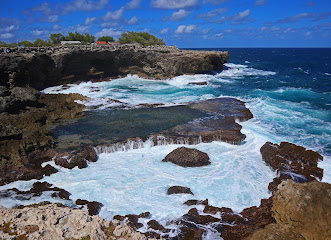Barbados
Jan 2nd - 6th, 2022
The second stop on my Caribbean island hopping trip was Barbados, which is the most easterly of all the Caribbean islands. The direct flight from Antigua to Barbados takes about an hour. It was a clear day and sitting on the right hand side of the plane gave me great views of Guadeloupe, Dominica and Martinique along the way. Spanish navigators first reach Barbados in the late 15th century, but it was the British who first established a European settlement in 1627. The island remained a British colony until it gained its independence in 1966. Barbados has a population of just under 300,000. Similarly to most other Caribbean islands the population is about 90% ethnically West African, the descendants of slaves. Starting in the early 1600s slaves from West Africa were mostly brought in to work on the sugar cane plantations, until the British empire abolished slavery in 1833. At the end of last year, the country officially became a republic, and Queen Elizabeth II was replaced as the head of state by Sandra Mason, the first president of Barbados.
I stayed at the Hilton Barbados Resort, which is located at the south-west corner of the island, at the point where the Caribbean Sea meets the Atlantic Ocean. This was the view from my balcony.
To get an overview of the whole island, I had booked a private guided tour through Viator, which started with a drive through Bridgetown and a brief stop at the Kensington Oval, the famous Barbados cricket ground. Barbados' most famous cricketer is Sir Garfield Sobers, who is honored with a statue in in front of the Oval.
But Barbados' most famous celebrity is Rihanna, who grew up in this house in a poor neighborhood of Bridgetown. The house has now been converted into the 'Rihanna Drive Monument' and can be visited by tourists.
We continued the drive along the west coast passing the mansions of the rich and famous and towards the sparsely populated north coast. Being the most easterly of the Caribbean islands Barbados faces the Atlantic Oceans. There is nothing between here and the West African coast. Apparently escaped slaves occasionally drowned along this coast, because they believed they could just swim back home to Africa from here.
We drove down the east coast, which is dotted by small fishing villages, but not a single hotel or resort is found on this side of the island. All of the tourism only happens on west and south coast, even though the landscape along the east coast is much more dramatic and beautiful, but the Atlantic waves and winds tend to be a bit fierce for a beach holiday.
This is the Morgan Lewis wind mill, which is the only surviving sugar wind mill in Barbados, and one of only two remaining in the world. In the 18th and 19th century, these types of windmills were used to grind the sugar cane.
Barbados is famous for it's rum. I went to a very interesting rum tasting at the Mount Gay distillery, which was founded in 1703 and claims to be the oldest commercial rum distillery in the world. We got to try 6 different types of rum (which turns out is quite a lot at 11 am when you've skipped breakfast), and learned a lot about the distilling and blending process. Although there is still some sugar cane being grown in Barbados, these days most of the molasses for the Barbadian Rum are imported from South America.
Barbados also has one UNESCO World Heritage site, called Historic Bridgetown and its Garrison, which received the award for being an "Outstanding example of British colonial architecture" from the 17th and 18th century. The Garrison is an impressive structure, which during the 18th and 19th century was the largest military garrison in all of the British colonies. It is still used by the Barbadian military today.
Right near the Garrison is the Washington House, named after George Washington, who stayed here in 1751 at age 19, during what is believed to have been his only trip outside of the present United States.
It's about a 30 minute walk from the Hilton resort into the city, and you can either walk along the road or take off your shoes ands stroll through the white sand of the huge Pebbles Beach, which like all beaches in Barbados is a public beach.
Bridgetown is the capital of Barbados, and has quite a few interesting colonial buildings, like the 19th century Parliament buildings and St Mary's Parish Church.
Bridgetown center was quite lively and busy, and I thought it was remarkable that everyone wore masks, even outside. They definitely seemed to take COVID a bit more seriously here than many people in the US and Europe.
After 4 very enjoyable days in Barbados and after successfully passing another COVID test, I continued my trip with a short hop on a propeller plane to Saint Lucia.



















No comments:
Post a Comment